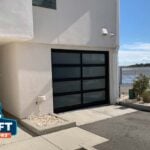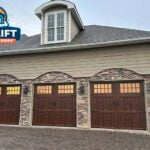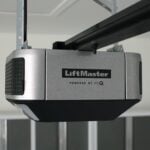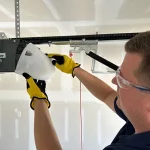
When your garage door starts making strange noises or behaves inconsistently, it’s more than just a nuisance—it’s a potential safety risk for your family. That familiar but annoying grinding sound or unpredictable opening and closing can be telltale signs that something isn’t right. Recognizing these early indicators can prevent more serious problems down the line.
Having spent weekends watching neighbors dive into hefty DIY projects and hearing stories of malfunctioning doors jeopardizing pets and children’s safety, I understand your concerns first-hand. Thorough research has gone into this guide to provide you with clear steps to spot issues before they escalate into costly repairs or dangerous situations. Regular checks not only keep your home safe but also ensure your daily routines proceed without disruption. With that in mind, let’s explore what to look for during your next visual inspection and performance test.
Signs that indicate your garage door needs repairs include slow opening and closing, jerking movements when closing, coming off track, unbalanced operations, loud or unusual noises, malfunctioning openers, broken cables or springs, and increasing energy bills due to poor insulation. If you experience any of these signs, it is recommended to have a professional inspect and repair your garage door.
How to Identify Garage Door Issues
Your garage door is a crucial part of your home, contributing to its curb appeal, value, and safeguarding your vehicles and possessions. Detecting potential issues early on can prevent costly repairs and ensure the safety and functionality of this essential feature.
Step I – Visual Inspection
A simple monthly visual inspection can help spot potential problems with your garage door. Look for visible damage such as cracks or dents on the panels, bent or misaligned tracks, or rusting components. Pay attention to gaps or misalignment between the door panels, as these could indicate structural issues affecting insulation and security. Additionally, observe any unusual sounds or grinding noises during operation, as these could signify mechanical problems needing attention.
Step II – Performance Test
After the visual inspection, perform a test by manually opening and closing the door to check for smooth movement along its tracks. Note any resistance, uncharacteristic movements, friction, or scraping sensations when operating the door, which could point to underlying mechanical or alignment problems.
Step III – Balance Check
It’s critical to ensure that your garage door is properly balanced to avoid safety risks and strain on the opener and other components. Disconnect the automatic opener and manually move the door halfway. If it stays in place, it’s balanced. However, if it slams shut or opens wide, there is an imbalance issue often involving worn-out springs.
Balancing issues are often associated with worn-out springs compromising smooth operation and structural integrity. Ignoring these signs can lead to further damage and safety hazards down the line.
By following these steps and regularly assessing your garage door’s condition, you can proactively identify potential issues before they escalate into costly repairs or safety concerns. Regular maintenance and vigilance will go a long way in ensuring the optimal performance and longevity of your garage door system.
Noises Indicating Problems
When it comes to your garage door, strange noises can give you insight into its well-being. Each sound has something to say, and if we listen closely, we can understand the underlying issues. Let’s explore a few common sounds and what they might indicate.
Types of Noises and Their Meanings
- Grinding Sound: If you hear a grinding noise, it could be a sign that the door’s parts need lubrication. It may also indicate metal-on-metal friction caused by worn-out rollers.
- Popping Noise: A popping noise typically points to tension issues, often involving the torsion springs. This is a critical sound that should alert you to potential problems with the spring mechanism.
- Squeaking: A squeaking noise is often a straightforward sign of lack of lubrication. However, it could also indicate that minor parts are wearing out and need attention.
Each of these sounds can reveal different problems within your garage door system. Understanding the meanings behind these noises gives you insight into what could potentially be wrong and where to focus your attention when troubleshooting.
Frequency of Noises
It’s not just about the type of noise, but also how often you hear it:
- New noises or an increasing frequency of existing sounds should prompt immediate attention. This is because such changes in the frequency or new noises may indicate developing issues that, if left unaddressed, could lead to more serious damage over time.
For instance, if you consistently hear a grinding sound when opening or closing the garage door that wasn’t there before, it’s definitely time to investigate and address the source of the issue. Similarly, any sudden increase in popping or squeaking sounds warrants an inspection and potential maintenance.
Ignoring such warning signs can lead to avoided repairs piling up into costly replacements down the line. Therefore, it’s crucial to heed these auditory cues and take proactive measures to address them promptly.
By understanding and recognizing these noises and their frequency, homeowners can proactively detect potential problems with their garage doors, preventing further damage and ensuring smooth operation for years to come.
Damaged Springs Warning Signs
Your garage door is like a mighty beast – strong and reliable, but also quite sensitive. The springs play a crucial role in its functioning, making it essential to recognize the signs of a damaged spring.
Visual Indicators
So, how do you know if your springs need attention? One clear sign to look for is any gaps in the springs, which could indicate that they are broken or on the verge of breaking. Rust or corrosion is another visual cue indicating that the springs are nearing the end of their lifespan. These visual indicators should raise a red flag and prompt you to schedule a professional inspection.
Operational Symptoms
It’s not just what you see, but also what you experience when operating your garage door. A worn-out spring can cause the door to close too quickly or sag when it’s only partially open. This imbalance affects the smoothness of operation and can pose safety risks. Pay attention to how your door’s motor behaves. If it’s struggling or straining during operations, it’s likely compensating for weak springs. This strain indicates that the motor is working harder due to compromised support from the springs.
Think of the springs as the muscles supporting the weight of your garage door. When these “muscles” start to weaken, other parts have to work harder to compensate for the deficiency. This extra strain can lead to premature wear and tear on other components, causing additional issues beyond just the springs themselves.
Understanding these operational symptoms is crucial because a properly functioning garage door should move smoothly and with relative ease. Any deviation from this norm may indicate underlying issues that need urgent attention.
Being vigilant about these visual indicators and operational symptoms is crucial in ensuring a well-maintained and safe garage door system.
Maintenance Tips for Longevity
Taking good care of your garage door can significantly impact its lifespan and operational efficiency. Similar to any other machine, frequent use requires regular checks and gentle care to ensure smooth functioning. Let’s review some practical tips to help you keep your garage door in top condition.
Regular Lubrication
Just like how your car needs oil to run smoothly, your garage door has moving parts that require proper lubrication. Applying a garage door-specific lubricant to all moving parts every six months helps reduce wear and tear and prevents unnecessary noise. This simple step can make a huge difference in the longevity of your garage door. It’s akin to giving it a little spa day to reward it for all the hard work it does for you.
Tighten Hardware
Similar to anything else that experiences frequent motion, the hardware on your garage door can loosen over time due to the constant up and down movement. Regularly inspecting and tightening bolts and roller brackets is crucial in preventing damage and ensuring the smooth operation of the entire system. This maintenance task is as important as checking the tire pressure on your car – taking time to tighten these components will help everything keep working as it should.
Clean Tracks
The tracks are a crucial but often overlooked part of your garage door system. They guide the door’s movement and ensure smooth operation. Dirt and debris buildup in these tracks can lead to issues with the door’s movement. Keeping the tracks free from debris and dust ensures your garage door moves smoothly every time you use it, similar to driving down a well-maintained road for a smooth ride.
These simple yet powerful tips are essential for maintaining the longevity and effectiveness of your garage door. By dedicating some time to these maintenance tasks, you can extend the life of your garage door and minimize unexpected repair costs. Remember, preventive care is key to avoiding larger problems down the line.
With an understanding of how these maintenance tips can impact your garage door’s performance, let’s now dive into common repairs that may be essential for keeping your garage door in top shape.
Common Garage Door Repairs
Just like any mechanical system, a garage door can develop issues over time. Let’s look at some of the common garage door repairs and why it’s important to address them promptly.
Sensor Adjustments
Garage door sensors play a crucial role in ensuring the safety and proper functioning of the door. These sensors prevent the door from closing if an object or person is detected in its path. If your garage door won’t close, the first thing to check is the sensors. Over time, sensors can become misaligned, dirty, or obstructed by debris, causing them to malfunction.
To address sensor issues:
- Check if the sensors are clean and free of any dust or debris.
- Ensure that the sensors are properly aligned to detect obstacles in the door’s path.
Regularly inspecting and making these adjustments helps avoid potential accidents and keeps your garage door operating safely.
Cable Replacement
The cables in your garage door system are responsible for lifting and lowering the door smoothly. However, over time, these cables can experience wear and tear, leading to fraying or snapping. This poses both a safety hazard and can lead to extensive damage to other components of the garage door system.
If you notice cable issues:
- Never attempt to repair or replace frayed or damaged cables yourself.
- Contact a professional garage door technician to inspect the cables and perform any necessary replacements.
Promptly addressing cable issues is crucial for maintaining safe and reliable operation of your garage door.
Panel Replacement
If one or more panels on your garage door are damaged due to impact or wear, replacing individual panels can be a cost-effective solution. Rather than replacing the entire door, which can be considerably more expensive, replacing damaged panels allows you to maintain the overall appearance and functionality of your garage door without unnecessary expenses.
Considerations for panel replacement include:
- Identifying the extent of damage on the affected panels.
- Consulting with a professional technician to assess whether panel replacement is a suitable solution for your specific situation.
Addressing panel damage early on prevents further deterioration while maintaining the aesthetic appeal of your garage without unnecessary expenses on full-door replacements.
Addressing these common garage door repairs in a timely manner is essential for ensuring the safety, functionality, and longevity of your garage door system. In understanding the importance of being proactive with these repairs, let’s now explore some additional vital aspects of maintaining optimal performance from your garage door.

When to Call a Professional
While DIY maintenance can be effective in many cases, there are specific situations where calling a professional is not just advisable, but essential. Here are some key instances when it’s best to leave the garage door repairs to the experts.
Safety Concerns
Garage door systems involve high-tension components such as springs and cables. These parts are under immense pressure and can be extremely dangerous to handle without the proper training and tools. Any issues related to the springs, cables, or the opener’s motor should always prompt a call to a professional. Attempting to address problems with these components without adequate knowledge and experience significantly increases the risk of serious injury. This includes cases where there is evidence of fraying cables, damaged springs, or malfunctioning opener components.
“It’s crucial to prioritize safety above all else when dealing with garage door repairs. Just like you wouldn’t try to fix a car engine if you weren’t a mechanic, it’s best to leave the intricate work of critical garage door components to those who are qualified.”
Persistent Problems
After attempting basic troubleshooting, if the problem continues to persist or reoccur frequently, it’s a clear sign that expert intervention is necessary. A professional technician can thoroughly diagnose the issue, identify the root cause, and implement a lasting solution. Ignoring persistent problems can lead to more extensive damage and costly repairs in the future. By calling a professional at this stage, you may actually save money in the long run by addressing the problem comprehensively from the start.
Maintenance and Inspections
Regular maintenance and inspections by a professional are essential for identifying potential issues before they escalate into major repairs. By investing in annual professional inspections, you can proactively address small concerns such as misalignments, worn-out parts, or insufficient lubrication before they develop into larger and more expensive problems.
“These annual check-ups are akin to regular visits to a doctor for preventive health care. Just as early diagnosis of health issues can prevent more severe conditions down the line, professional inspections help maintain the optimal functioning of your garage door system while avoiding potentially costly emergency repairs.”
Contact Skylift Garage Doors Today
Knowing when to call for professional help ensures that safety is prioritized and that persistent problems are addressed promptly before they become larger issues. Professional maintenance and inspections also go a long way in preventing major repairs and preserving the integrity of your garage door system over time.
Calling a professional when necessary not only ensures safety but also saves you from further damage and costly repairs down the road. Remember, prevention is better than cure when it comes to maintaining your garage door system.




